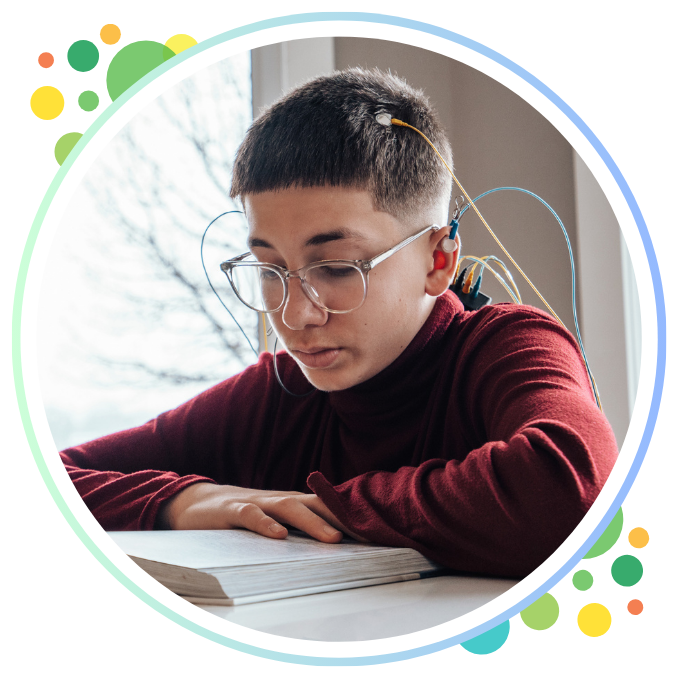VIDEO TESTIMONIAL
A Mom's Journey: How Neurofeedback Helped My Family Thrive Academically
In this video testimonial, a mom shares how our program helped one son with learning delays and both sons to thrive academically. She also gave her tips for home neurofeedback sessions.

Empower Yourself Through Education
Are there evidence-based natural treatments for ADHD?
Various alternatives to medication can be effective in managing ADHD symptoms. Psychotherapy is a common approach, including cognitive-behavior therapy (CBT), which can help individuals develop coping strategies for ADHD symptoms and improve self-esteem. Neurofeedback, a type of biofeedback, is another technique that teaches individuals to alter brain activity through training, thereby improving concentration and reducing impulsivity.
Behavioral techniques, recommended especially for children under six years old, are often used as a first-line treatment. As children grow older, these techniques can be combined with medication or other therapies.
Exercise can be highly beneficial, helping to boost attention and improve executive functions like planning and prioritizing. Spending time outdoors can also be helpful, providing a break from voluntary attention and aiding focus.
Dietary changes and supplementation, like omega supplements, can be advantageous for those with low omega fatty acids levels. Some research suggests that these supplements can improve ADHD symptoms. Elimination diets, which involve identifying food sensitivities and removing specific foods, may also alleviate symptoms.
Mindfulness practices, such as meditation, promote being present in the moment, reducing negative feelings, and anxiety. This can help individuals with ADHD manage impulsivity and restlessness.
Because each individual’s symptoms and severity are unique, it is important to consult with a healthcare professional to understand that these approaches often work best as complements to traditional treatments.
Watch more video testimonials
A mom and son discuss how neurofeedback helped his ADHD symptoms. Luigi's school performance improved significantly with neurofeedback training. This interview took place a year and a half after he completed 3 months of weekly neurofeedback sessions.
Q&A: A non-invasive Approach to ADHD
Is neurofeedback effective for treating ADHD?
Neurofeedback research for ADHD has been conducted since the 1970s. Research conclusions are mixed. https://pubmed.ncbi.nlm.nih.gov/31139966/ Our anecdotal observations are that it is an important support for ADHD. For parents who do not want to start with medication we recommend three months of neurofeedback to assess how much change happens with the neurotherapy alone, then adding medication and ADHD coaching as needed.
How do you get the best results from neurofeedback?
We always recommend a holistic approach, combining a good whole-foods based diet with less processed foods and sugar, regular exercise and 9-10 hours of sleep per night. Neurofeedback helps to optimize brain functioning and creates a good foundation to then add ADHD executive functioning coaching and medication as needed. We also see the best results in children when one caregiver also does neurofeedback. Nervous systems are connected, when the parent’s brain is also optimizing its functioning and lowering stress, it supports the child’s brain regulation.
What age groups can benefit from neurofeedback for ADHD?
Neurofeedback for ADHD can be done at any age. And with the neurofeedback devices that are non-invasive, children as young as two-years-old can safely do sessions. We use NeurOptimal neurofeedback, which is safe to use at any age.
Are there any side effects of neurofeedback?
In general, neurofeedback is considered to be a non-invasive procedure with minimal side effects. Protocol neurofeedback, where the trainer has to set protocols based on a QEEG brain map, can have temporary side effects from over-training brain regions. These symptoms, such as drowsiness or being overly alert, usually last less than a few days.
How many sessions of neurofeedback are needed for ADHD?
This varies by individual and the type of neurofeedback. Typically we see children in neurotherapy for 6 months of 1-2 sessions weekly in-office, or three months of 3-4 sessions weekly of at home neurofeedback.
With any form of brain training, the number of sessions as well as the timespan of training is meaningful. For example, the brain takes weeks to create new neural connections. Health of the individual also plays a role in the number of sessions needed.
Is neurofeedback covered by insurance
Coverage varies by insurance plan and location.
Can someone stay on medication and do neurofeedback?
Yes, you can stay on medication while doing neurofeedback. We recommend clients already on medication to stay on their current dosage and as improvements are seen and stabilized, to work with their prescribing physician to taper off medication. Individuals should always discuss changes with their provider before decreasing their medication.
Program Overview
-
Age appropriate
Non-invasive Neurofeedback for ADHD can be done at any age.
-
No side effects
In general, neurofeedback is considered to be a non-invasive procedure.
-
Insurance?
Coverage varies by insurance plan and location.
-
No interferance
Yes, you can stay on medication while doing neurofeedback.
-
Research based
Neurofeedback research for ADHD has been conducted since the 1970s.
-
Home neurofeedback
Professional-grade home neurofeedback available
.png?width=420&height=180&name=holistic-healthy-brain-logo-website-with-tagline-transparent%20(3).png)